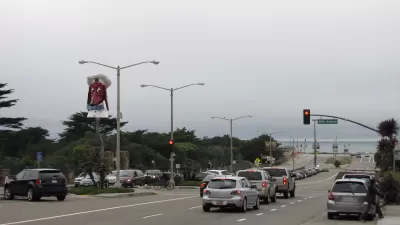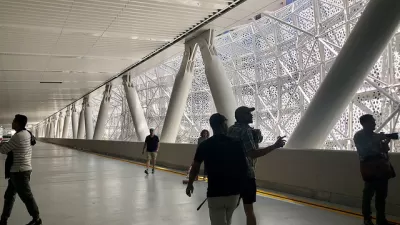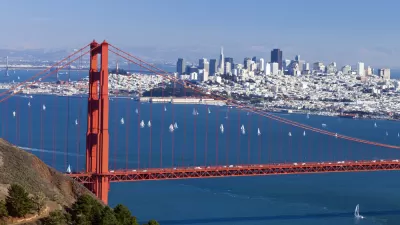The urban design critic for the San Francisco Chronicle publishes a new book of 50 of his favorite San Francisco structures.

Michael Krasny talks with John King for KQED public radio about his new book, Cityscapes 2: Reading the Architecture of San Francisco. The book describes 50 of King's favorite architectural works in San Francisco, some well-known icons and other obscure treasures. For example, he says about the Golden Gate Bridge, "We've all got the postcard image in our head...when you're actually there... it's stunning. It's such a rugged, powerful work...a man-made imposition on the landscape, and it makes it better."

The book is divided into four sections:
Towers, such as the Russ building. "It's not a city defined by it's towers. But in fact, this is a big city, and the tall buildings are what signify the larger aspirations of the city...The Russ building really captures the whole kind of romantic glory of what people think a downtown could be-or should be. It's such a classic, old-fashioned, step-back skyscraper."
Connections—what King calls "the things in between." One of the most obscure in the book is a stone footbridge in the an army-era wetland of the Presidio's Dragonfly Creek. But he also discusses the importance of less obviously pretty structures. "A lot of us wish the highways would just go away, but the fact is you have to have roads, you have to have connections. And you can do them elegantly."
Clues, which "show the range of ways in which architecture can hint at something much larger, from shifting neighborhood demographics to the demise of a once-imposing freeway."
"Doggie Diner, that's a clue to the city's psychology. Why on earth is there a Doggie Diner head out by the zoo that's selling for a chain that's long ceased to exist? It's because San Francisco loves the notion of itself as a kitschy, iconoclastic, kinda old-school place." Krasny questions whether or not that mindset still exists with gentrification, and King is affirmative. “Look at how techies with ten times our combined income want to go to the cool little old bar where they can feel like they're sitting around with other old school San Franciscans remembering how the place a year ago was a lot less pretentious than it is now."

Finally, the Waterfront, "a way of looking at the waterfront as part of the city."
The interview discusses the much-anticipated Transbay Transit Center. "The enormity of what is being built is only now becoming apparent. I'm kind of enjoying just watching it go up. It's going to be such a strange presence in the city. The thing is so colossally over budget." And Krasny questions King about his designation of the Mission as San Francisco's cultural center. "The thing about the Mission that I really appreciate is there is so much to it. You just see the collision of layers. You really see all the different drivers. The remnants of the blue collar city, the immigration streams..It's a place people want to be in, which leads to the disruption and tension now."
"Mission Bay looks like Soviet-era development," chimes in a listener. King argues this is a result of a highly formulaic process with prescriptive planning rules. "A lot of times the most creative new buildings, they tend to be smaller. They tend to be on the edge of things...The whole drive [in Mission Bay] was to make sure that nothing unexpected happened.” He discusses how similar processes occur in his hometown of Berkeley. “Berkeley is considered such a liberal town and yet the bureaucratic process is so cumbersome that the architecture is fairly conservative. Innocuous enough that the design committee will live with it and the city will waive it through."
"A lot of what's getting done now is formulaic. You need good local developers and architects who understand a place but also have some imagination about how to keep that place moving forward and how to make it better. You look at the kind of fights that go on in the Bay Area, and that wouldn't go on in a lot of regions. In the Bay Area, you tend to get people who are too defensive, too cynical, who take too much delight in knowing how to delay the process, and there's always another challenge to the Environmental Impact report that will stretch it out another 18 months." He cites Treasure Island as an example. "But the fact is, people are like that because the Bay Area is such a remarkable place: It's such a remarkable fusion of nature and urbanity."
FULL STORY: Urban Design Critic John King on the Structures that Define San Francisco

Trump Administration Could Effectively End Housing Voucher Program
Federal officials are eyeing major cuts to the Section 8 program that helps millions of low-income households pay rent.

Planetizen Federal Action Tracker
A weekly monitor of how Trump’s orders and actions are impacting planners and planning in America.

Ken Jennings Launches Transit Web Series
The Jeopardy champ wants you to ride public transit.

California Invests Additional $5M in Electric School Buses
The state wants to electrify all of its school bus fleets by 2035.

Austin Launches $2M Homelessness Prevention Fund
A new grant program from the city’s Homeless Strategy Office will fund rental assistance and supportive services.

Alabama School Forestry Initiative Brings Trees to Schoolyards
Trees can improve physical and mental health for students and commnity members.
Urban Design for Planners 1: Software Tools
This six-course series explores essential urban design concepts using open source software and equips planners with the tools they need to participate fully in the urban design process.
Planning for Universal Design
Learn the tools for implementing Universal Design in planning regulations.
Ada County Highway District
Clanton & Associates, Inc.
Jessamine County Fiscal Court
Institute for Housing and Urban Development Studies (IHS)
City of Grandview
Harvard GSD Executive Education
Toledo-Lucas County Plan Commissions
Salt Lake City
NYU Wagner Graduate School of Public Service





























